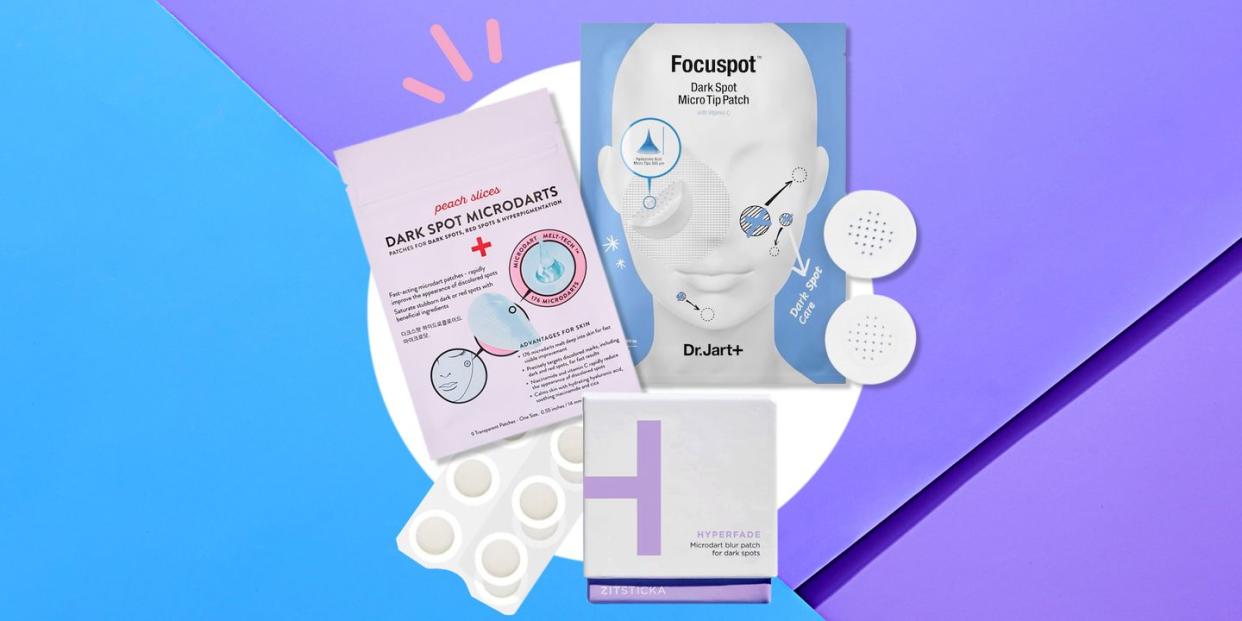These Stickers Can Brighten Dark Spots From Acne–And Derms Approve

First, there were pimple patches. Popularized by K-beauty, Americans quickly took to these handy, nearly-invisible stickers that help prevent picking and zap zits under the radar. (ICYMI: Most zit stickers are simply hydrocolloid patches, a medical-grade material that’s long been used for wound dressing to soak up fluid). So, of course, the natural next step was to apply the idea to other skincare concerns. Enter: Dark spot patches. Being that hyperpigmentation is another issue pimple prone complexions face, it only makes sense that a dark spot treatment would be the next patch innovation.
Rather than using an all over brightening serum, these targeted treatments use tiny darts (no, they don't hurt) filled with brightening ingredients to specifically lighten up the dark marks that acne can leave behind. Okay, this all sounds great (who among us hasn’t had a pesky dark spot we wished we could make disappear). But to be sure, we checked with top dermatologists to get their opinions too. And good news: They’re on board (for the most part). “I actually love them and use them all the time,” says Shari Marchbein, MD, a New York City-based dermatologist. Here's what you need to know.
A post shared by Peace Out Skincare (@peaceoutskincare) on Apr 24, 2020 at 5:27pm PDT
The ingredients aren't new, but the delivery method is.
Most patches contain ingredients she wholeheartedly approves of when it comes to treating dark spots—think niacinamide and tranexamic acid, with different combinations of other approved brightening ingredients, like vitamin C, licorice root extract, and glycolic acid. These are the same ingredients Dr. Marchbein seeks in non-patch products for fighting hyperpigmentation, too. “The ingredients in many of these products are ingredients I know, love and use and they have great evidence in helping to reduce hyperpigmentation and evening out skin tone,” she says.
Still, she notes, “hyperpigmentation has various causes and can be difficult to treat,” which means sometimes there are more heavy-duty ingredients brought in to fight these pesky dark spots. “In addition to some of the ingredients in these patches, we use hydroquinone, retinoids, kojic acid, various chemical exfoliants and acid peels, and even lasers to treat hyperpigmentation.”
Dark spot patches should only be used to treat post-acne scars.
The ingredients contained in these stickers work by “blocking production of abnormal pigmentation and soothe inflammation to brighten the skin," says Joshua Zeichner, MD, a New York City-based dermatologist. “They are a great option for individual spots but are not a good option for widespread pigmentation, where traditional serums are a better options,” Zeichner explains. It's best to not use these patches for conditions like "melasma that affect broad areas, but for post inflammatory marks like post-acne spots," adds Michelle Henry, MD, a New York City-based dermatologist.
Dark spot patches may be irritating for super sensitive skin.
While many of the hyperpigmentation patches on the market include all the right ingredients, it’s important to note that the concentrations are not always specified. So, though Dr. Marchbein wholeheartedly endorses non-medicated patches which “help keep your hands off your face, especially for people who tend to pick or pop their acne," and which can itself be a huge cause of post inflammatory hyperpigmentation, she warns that in some cases, having these ingredients in an occlusive form, stuck to your skin, might be too harsh and further irritate the skin.
So before you slap one on and head to bed, try a test. “Although the skin on the arm is different than the face, I would recommend testing these patches on the inner arm, before applying it to the face,” to see if you have any kind of adverse reaction, Marchbein says. “If someone has very sensitive skin, I would consider avoiding these medicated patches all together and obviously if there is an adverse reaction, seek care immediately from your dermatologist (don’t try to treat the irritation as that can make the irritation and the hyperpigmentation worse),” she explains.
Ready to try a dark spot patch IRL? Right this way:
Peach Slices Dark Spot Microdarts
These new microdart patches contain four percent niacinamide, licorice root extract, and vitamin C at a drugstore price point.
Zitsticka Hyperfade
Zitsticka’s latest patch contains 24 self-dissolving microdots that melt into your skin over the course of two hours supplying it with niacinamide, arbutin, tranexamic acid, kojic acid, and licorice root extract.
Peace Out Microneedling Dark Spot Brightening Dots
Tranexamic acid, licorice root extract, and niacinamide work together to treat dark spots. In a two-week consumer study, 100% of users said dark spots looked lighter and less noticeable.
Hero Cosmetics Micropoint for Dark Spots
These micropoint patches contain a whopping 173 microneedles designed to flood the skin with the brightening power of beta glucan, vitamin C, niacinamide, and tranexamic acid.
Dr. Jart+ Focuspot Dark Spot Micro Tip Patch
These brightening patches deliver Vitamin C and niacinamide to any dark spots that need some help.
You Might Also Like

